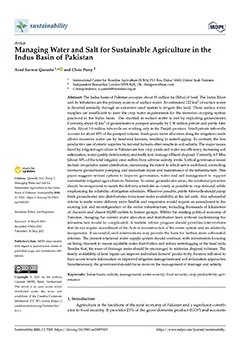Managing Water and Salt for Sustainable Agriculture in the Indus Basin of Pakistan
The Indus basin of Pakistan occupies about 16 million ha (Mha) of land. The Indus River and its tributaries are the primary sources of surface water. An estimated 122 km3 of surface water is diverted annually through an extensive canal system to irrigate this land. These surface water supplies are insufficient to meet the crop water requirements for the intensive cropping system practiced in the Indus basin. The shortfall in surface water is met by exploiting groundwater. Currently, about 62 km3 of groundwater is pumped annually by 1.36 million private and public tube wells. About 1.0 million tubewells are working only in the Punjab province. Small private tubewells account for about 80% of the pumped volume. Inadequate water allocation along the irrigation canals allows excessive water use by head-end farmers, resulting in waterlogging. In contrast, the less productive use of erratic supplies by tail-end farmers often results in soil salinity. The major issues faced by irrigated agriculture in Pakistan are low crop yields and water use efficiency, increasing soil salinization, water quality deterioration, and inefficient drainage effluent disposal. Currently, 4.5 Mha (about 30% of the total irrigated area) suffers from adverse salinity levels. Critical governance issues include inequitable water distribution, minimizing the extent to which salt is mobilized, controlling excessive groundwater pumping, and immediate repair and maintenance of the infrastructure. This paper suggests several options to improve governance, water and salt management to support sustainable irrigated agriculture in Pakistan. In saline groundwater areas, the rotational priorities should be reorganized to match the delivery schedules as closely as possible to crop demand, while emphasizing the reliability of irrigation schedules. Wherever possible, public tubewells should pump fresh groundwater into distributaries to increase water availability at the tail ends. Any substantial reform to make water delivery more flexible and responsive would require an amendment to the existing law and reconfiguration of the entire infrastructure, including thousands of kilometers of channels and almost 60,000 outlets to farmer groups. Within the existing political economy of Pakistan, changing the current water allocation and distribution laws without modernizing the infrastructure would be complicated. A realistic reform program should prioritize interventions that do not require amendment of the Acts or reconstruction of the entire system and are relatively inexpensive. If successful, such interventions may provide the basis for further, more substantial reforms. The present rotational water supply system should continue, with investments focusing on lining channels to ensure equitable water distribution and reduce waterlogging at the head ends. Besides that, the reuse of drainage water should be encouraged to minimize disposal volumes. The timely availability of farm inputs can improve individual farmers’ productivity. Farmers will need to have access to new information on improved irrigation management and soil reclamation approaches. Simultaneously, the government should focus more on the management of drainage and salinity.
